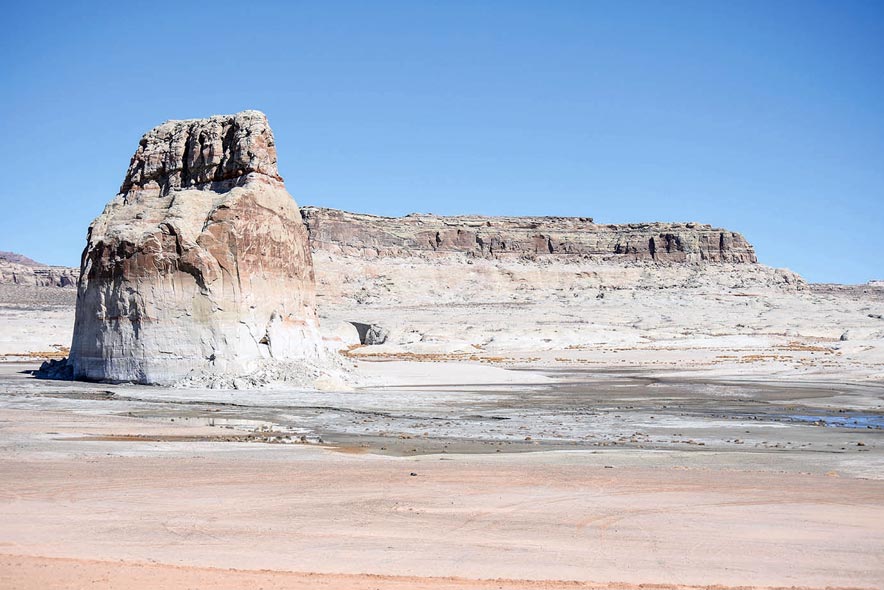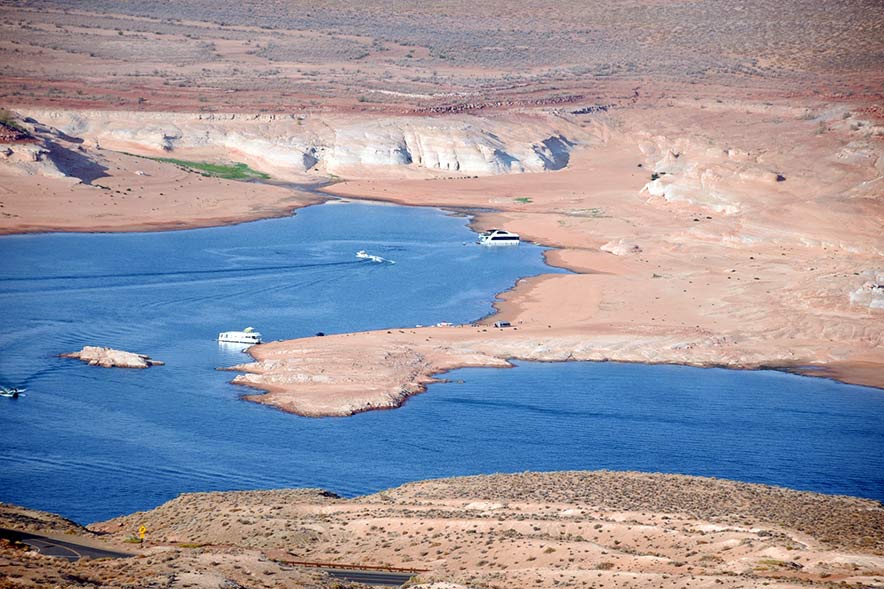
‘Islands’ resurfacing as Lake Powell nears critical level

Navajo Times | Krista Allen
Lone Rock, a solitary sentinal at Wahweap Bay in Lake Powell, is less than 10 miles from Glen Canyon Dam in the Glen Canyon National Recreation Area. Lone Rock shows “bathtub rings” and reveals the cost of the Colorado River drought on Monday, Feb. 28.
DÁ’DEESTŁ’IN HÓTSAA-HAAL’EEŁÍ
One of the largest reservoirs in the U.S. is reaching its lowest level recorded since it began filling nearly 59 years ago.
The water level at Lake Powell, the declining Colorado River reservoir that straddles the Arizona-Utah line and relies mainly on Rocky Mountain snowmelt, is likely to dip below 3,525 feet – benchmark water managers have long tried to avoid – in a few days.
The reservoir is at 3,526.80 feet above sea level, falling 173.20 feet below full pool, as of March 1. By content, the reservoir is 24.82% of the full pool.
Water managers are closely watching whether the water level will drop below 3,525 feet. If it does, this will threaten the capability of Glen Canyon Dam to generate power supply for the West’s rapidly growing population across seven states – Wyoming, Utah, Colorado, New Mexico, Arizona, Nevada, and Nebraska.
This means 10 to 20 feet can make a big difference.
“The water level in the (reservoir) are nearing critical state at this particular time,” said Page Mayor Bill Diak. “We should start seeing lake levels starting to come up. I’m hopeful that we will see them come up quite a bit.
“We need one more good storm out West, in the Rockies, for that to happen,” he explained. “We have only one ramp (Wahweap Stateline Auxiliary Launch Ramp) at this time that’s open for access to the lake.”
According to the National Park Service at Glen Canyon National Recreation Area, the auxiliary ramp is open to all vessels.
But there may be partial lane closure delays for construction, where contractors are regrading and extending the ramp with concrete to reach the reservoir elevation.
Diak said the low water level affects the lower portion of the reservoir at Wahweap Bay, where vessels had to be moved around the buoy fields, and docks had to be moved because the water shallowed.
“There are a couple of islands that are coming up under the docks themselves,” Diak said. “And some docks had to be removed, and that’s problematic for us here.
“And losing access to Antelope Point, where there is no public ramp, as well as Halls Crossing and Bullfrog (Utah),” he said. “All of (these) areas attribute to visitation to our region, and it’s kind of tough not to have those lake accesses. The park service is also working on an access ramp in Bullfrog.”
The park service selected a contractor Feb. 2 for the Bullfrog North Ramp Extension Project that would be completed in May. Ramp use would be dependent on lake levels.
“For nearly a year now, we’ve had no access at the other end of the lake,” Diak said. “It’s kept boaters from here (Wahweap) to Bullfrog, or Bullfrog down, which is a 100-mile journey.”
And Dangling Rope Marina doesn’t exist in the canyon where it once was, said Diak. There isn’t enough room.
“Park service is looking at a temporary area for (the Dangling Rope Marina),” he said.
Intense drought

Navajo Times | Krista Allen
A long drought on the Colorado River shows a shrinking Lake Powell near Wahweap Bay on Aug. 2, 2021.
Lake Powell began filling on March 13, 1963, and completed on June 22, 1980, reached a full elevation of 3,700 feet above sea level.
At capacity, the reservoir holds more than 26 million acre-feet of water that originates as snowpack from the Upper Basin states – Colorado, Utah, Wyoming and New Mexico.
The reservoir extends through the main corridor of Glen Canyon and into at least 90 side canyons that extend outward.
The U.S. Bureau of Reclamation and many climate experts attribute the reservoir’s decline to the effects of climate change such as drought, excessive heat, and reduced snowfall. Federal water managers have been forced to reconsider how supplies will be portioned out this year.
The Upper Basin and Lower Basin states in the Colorado River Basin in 2019 signed drought contingency plans to protect the water in the region. Part of the Upper Basin deal included a drought response operations agreement to buffer critical elevations at Lake Powell.
The agreement defined the 3,525-foot mark as a target elevation for the reservoir. The target elevation provides a 35-foot buffer above the lowest elevation at which Glen Canyon Dam can generate power.
Downstream in the Colorado River water management system, Lake Mead is filled to 34.54% of capacity.
Nine western states are affected by some level of drought, according to a Feb. 24, report from the U.S. Drought Monitor.
“When you think of Lake Powell and Lake Mead, you’ve got to understand the purposes of what these two lakes are,” Diak said. “They’re reservoirs, (which) is the storage of water and times of plenty to be used in times of need.
“(Lake Powell) covered up a beautiful canyon,” he said, “but as our country is growing, we’ve done the best job we can to try to make sure that we have the adequate supplies of water for the Southwest.”
Diak said that because of access restrictions to the lake, there could be fewer visitors this summer even though many people visit.
“Once people get here, the burden of trying to launch and retrieve boats with only one access – that time is very lengthy because there’s only one point to go in and only one point to go out,” Diak added. “Whereas you take that a year and a half ago, two years ago, we had three locations at one end of the lake.”
Dá’deestł’in Hótsaa Delegate Paul Begay, who represents five northwestern chapters, said if there are no launch ramps, the business of water-related activity is going to be a problem for the Page-Lake Powell region.
“That will contribute to lack of employment because water is what we need in the area to run business, take care of employment,” Begay said. “A lot of our Navajos are employed seasonally and (the low water level) will affect us.
“It’s a major part of our concern (in the northwestern chapters) right now,” he added. “It triggers, and it’s a domino effect. It affects everybody in the immediate area and everybody down lake that uses the water as a power source. We’re talking about a big land base.”







 Highway 264,
Highway 264, I-40, WB @ Winslow
I-40, WB @ Winslow